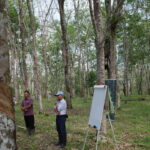Ksapa recently organized a webinar on the legal and tax considerations of US Foundations’ Mission-related investments (MRIs) and Program-related investments (PRIs). This webinar was organized in the continuity of Ksapa’s briefing paper – written by Julie Muraco – exploring elements of change in the use of endowment assets for social capital. MRIs and PRIS are designed to create positive social impact combined with a certain degree of financial return. Despite this similarity, each type of investment has different legal and tax consequences for investing, particularly for private foundations.
The question then arises as to what are the relevant legal and tax considerations around the use of PRI and MRI? How can the board, management and staff become proficient in transitioning towards impact strategies? What are the fiduciary considerations? Is the organization prepared and positioned to make an impact policy decision?
To share actionable methodologies, tools, and collaborative initiatives, we welcomed the insights of Christine Looney, Deputy Director of Mission Investments at Ford Foundation, and David Miller, Partner at Proskauer Rose LLP.
Evolution of Responsible & Impact Investing Strategies
History of Socially Responsible Investing
Socially Responsible Investing is not new. There are records of first investment management strategies taking specific matters into consideration. Quakers Friends Fiduciary adopted a no firearm, alcohol, tobacco investment policy, endowment funds leading divesture movements against Vietnam war, Apartheid, or more recently against fossil fuels. These are examples of negative screening, the main form of SRI up until now. Indeed, SRI is just the preliminary form of ESG (Environmental Social Governance) risk management.
ESG Risk Management & Impact Investing
Since then, the investment space has evolved through the years with a multitude of strategies from negative screening or passive management to active strategies of ESG or impact investing, which are now being used by program-related investments (PRIs) and mission-related investments (MRIs) investment vehicles.
With the multiplication of strategies, the number of terms & expressions coined has surged, bringing additional confusion to an already complexed environment. Raphael Hara distinguishes two approaches: ESG investing, an internally oriented risk management approach used to minimize a company’s environmental, social, and governance-related risks; and impact investing, a movement trying to address systemic issues through positive impact. In other words, we can refer to ESG investing as “damage control”, while impact investing refers to a positive contribution to the SDGs.
While some say that impact is still not enough to foster a regeneration of the economy, private sector needs to be engaged in positive contribution strategies in order to bridge the SDG financing gap: around $4 trillion before COVID, now closer to $5 trillion. In this regard, private foundations in the United States hold a large SDG-funding potential which can be activated through specific investment strategies.
US Foundations’ MRIs & PRIs
Foundations’ Tax Regimen
US tax law dictates that private foundations must spend 5% of their assets value each year for direct charitable purposes. This takes the form of multiple grants awarding initiatives that further foundations’ specific tax-exempt purpose.
However, this distribution requirement only covers 5% of a foundation’s assets, with the 95% remaining usually invested by the investment advisor into non-risky products, following its fiduciary duty.
The purpose of the previous briefing paper and this webinar series, is to explore how foundations’ PRIs & MRIs could be used as investment vehicles supporting impact investment strategies that are aligned with a foundation’s purpose.
Defining PRIs
The US Treasury Code defines Program-related Investments (PRIs) as investments:
- Primary purpose of which is to accomplish one or more charitable purposes
- No significant purpose of which is the production of income or appreciation of assets
- No purpose of which is to influence legislation or intervene in political campaigns
As outlined by David Miller, once qualified as PRI an investment can yield several benefits:
- PRIs are treated as “qualifying distributions”, meaning that they can be used to satisfy the 5% rule
- They are excluded from assets considered for determining minimum investment return
- and hold several tax benefits:
- Gains on PRIs not subject to tax on net investment income
- PRIs are not treated as jeopardizing investments
- PRIs are not treated as “business enterprises”, meaning a foundation can hold equity of businesses without limitation
However, PRIs can give rise to Unrelated Business Taxable Income (UBTI) if the investment is not related to the tax-exempt purpose of the organization (loans not included).
Defining MRIs
Contrary to PRIs, mission-related investments (MRIs) are defined as an investment that:
- Seeks to generate reasonable rate of return on capital
- While also furthering a social purpose
As such, MRIs do not qualify as PRIs.
How Can a Foundation’s Board Qualify an Investment as PRI?
In order to qualify investments as PRIs, David Miller highlights several points in the regulation. There are two tests to qualify an investment as PRI. Each test helps assess if the investment satisfies the first two conditions of PRIs’ definition.
- Primary purpose test is in two parts:
- Investment must “significantly further” the accomplishment of the foundation’s exempt purpose. To be satisfied, foundation must determine that investment furthers with one or more section 501(c)(3) purposes.
- And investment would not have been made “but for” its relationship to the foundation’s tax-exempt purpose.
- No significant purpose test:
- Here the regulator asks: “would investors make this investment, if they are seeking return-based investment?”
- As such, the fact that the investment produces income is not, in absence of other factors, enough to conclude of a significant purpose. Meaning that investments producing income can be qualified as PRIs.
In this respect, the IRS gives several examples of investment that can be qualified as PRIs, such as:
- Foundations can invest in a for-profit business if the purpose of the investment is charitable: below-market loan to minority-owned business for example.
- Foundations can also invest in for-profit & profitable pharmaceutical companies, if it is to develop a vaccine to prevent a disease affecting poor individuals in developing countries, and if the company would not have the resources to develop the vaccine.
As such, PRIs qualification & definition can be very specific to each case.
PRIs & UPMIFA
The Uniform Prudent Management of Institutional Funds Act provides guidance for investment decision-making by charitable institutions in 49 states. The Act directs the charity to focus on the purposes and needs of the charity rather than on the purposes and perpetual nature of the invested assets.
In this respect, PRIs are qualified as “program-related assets” (includes investments), defined by UPMIFA as assets held by an institution to primarily accomplish a charitable purpose, not primarily for investment. As PRIs are excluded from UPMIFA and its stringent “prudential” spend down rate, it gives foundations’ more liberty in using PRIs as impact investment strategies.
However, while UPMIFA does not apply to PRIs, if some assets serve as investments for an institution, then the institution should report those investments in identified categories & establish investment criteria for investments that are reasonably related to achieving institution’s charitable purposes.
PRIs & MRIs in Practice: Ford Foundation
Furthering Foundations’ Impact
During our webinar, we had the opportunity to discuss foundations’ investments with Christine Looney from the Ford Foundation. The Ford Foundation has always wanted to explore instruments other than grants within the investment space to further the causes defended by the foundation. Having find none, the Ford Foundation decided in an unprecedented move to lobby congress in order to create the PRI tool. Since then, it has committed over $800 million in PRIs.
However, before engaging massive investments in MRIs & PRIs, the Foundation had to engage in a self-questioning processing, notably to answer the elephant in the room of most foundations when it comes to endowment, as Christine Looney puts it: “what are we doing with the other 95%?”
Engaging the Board of Directors
This questioning process was also timely when considering the movements within the impact space: some legal barriers removed by the IRS’ change of position in 2015, new talents and innovations coming on the market…
As Christine Looney points out, it is also important that leadership kicks-off this questioning process, and the arrival of Darren Walker, as new director at the Foundation, was thus decisive. Indeed, Mr. Walker has adopted quite a radical stance: “I no longer find it defensible to say that our investment strategy is only to maximize the value of our endowment—just as it’s no longer defensible for a corporation to say its only responsibility is to maximize shareholder value.”
This critical questioning process with the Board was then centered around three dimensions:
- Impact – What do we mean by mission-investment strategy for our endowment?
- Return – Can we achieve financial return on our portfolio while continuing endowment, grants…?
- Operations – How can this be operationalized? How can we build this portfolio?
The end result was the approval by the board of a $1 billion envelope to be invested over 10 years in mission-related investments. Out of this, $300 million have already been committed to projects supporting the 5 investment strategies defined by the Foundation: affordable housing, financial inclusion, diverse managers, biotech, quality jobs.
Furthering Development & Mainstreaming of MRIs & PRIs
As stated by Christine Looney, it is also the role of foundations to share lessons learned when it comes to investment practices. In her view, PRIs & MRIs represent a unique opportunity for philanthropy in the United States, a chance to redefine philanthropy and its means of action to contribute more.
Raphaël Hara also points out how PRIs & MRIs can help structuring an investment vehicle: PRIs are well adjusted for the concessional / catalytic capital side (below-market loan or 1st loss loan for example), while MRIs qualify as “finance first” impact investment with a market-rate return, mixing both help adjust the risk & return while working in the same direction.
In this respect, Ksapa also develop its own impact investment strategies that can qualify as PRIs or MRIs. Indeed, Ksapa’s SUTTI initiative designs large-scale capacity-building programs to disseminate sustainable agricultural practices to smallholders in Asia & Africa, supported by multi-stakeholder coalition of corporates, development agencies, and leveraging innovative finance to scale.
Conclusion
To summarize, responsible investing has greatly evolved since the days of the quakers, and within the impact investing space, US private foundations now have two tools at their disposal: PRIs and MRIs. While both contribute to the achievement of the mission, they each have specificities when considering risk or return. This will allow for the development of tailored structures, mixing PRIs and MRIs, for maximum impact. While these strategies remain within the private equity space, it is critical to open up to the listed equity universe, and by that to standardize impact instruments in order to achieve significant contribution to the SDGs.
Adrien is a SUTTI Program Officer. He’s responsible for the development, operational implementation, and monitoring of SUTTI programs. He participates in designing financial structuring schemes leveraging SUTTI’s impacts.
He has previous experiences in various industries, within public, private, and non-profit organizations. Before joining, he was involved in microfinance and social entrepreneurship initiatives in Cambodia and the Philippines, after working for Danone and RATP.
He holds a Master’s in Finance from Paris-Dauphine University, as well as a Master in Management from ESSEC Business School.
He speaks French, English, and Spanish.







